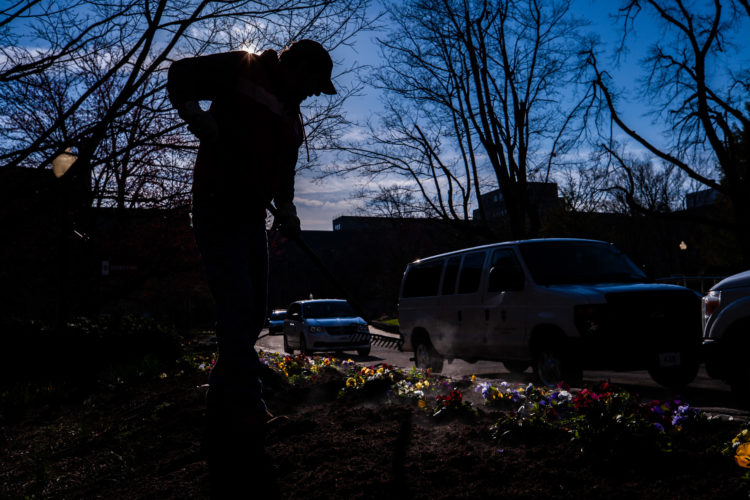Walking onto campus one morning in early April, coffee in hand, I approached Indiana University’s iconic Sample Gates. It’s always a spirit-lifting sight, especially with the statue of Ernie Pyle on the periphery. The gates were backlit by the rising sun. Landscapers were shoveling mulch onto freshly-planted flower beds. The mulch must have been warmed, because steam was rising. The men were silhouetted with their pitchforks, black against the awakening campus. The flowers were lit just enough.

I patted my pockets for a camera, then remembered that I had students to think about. So I texted two in my class who I thought might be nearby with cameras. They both caught up to the landscapers before the light shifted. One learned the story of a 35-year veteran of the landscaping crew who was retiring this summer. The other, a senior named Emily Miles with a dazzling talent for both writing and audio storytelling, had a previously scheduled conference in my office later that morning. She’s first on my regular round of student story conferences, so often gets the idea on the top of my mind, for better or worse.
“I’ve just been thinking about spring,” I said. “Is it spring or is it not spring?”
Midwestern weather is tricky, and I’d put away and unpacked winter boots three times already. That morning, the landscapers had been going through the motions of spring, but winter was clinging by its witchy little fingernails.
We’d had an intense semester. Emily had done a 3,000-word narrative on Drag Queen Story Hour, a national controversy playing out two hours away. Another student had scooped the local paper and felled a mayoral candidate. A third was working on a touchy exclusive. They were prepping for finals and looking for internships and trying to keep the best student newspaper in the country running smoothly. Two people would cry in my office that day.
I’ve tried to remind them, all semester, that every story doesn’t have to win a prize or take four months or get someone fired. Joy is a news value, too. We’d had beautiful stories about college hijinks and interstellar love and even an obit of a squirrel. In our class GroupMe chat, I’d told them, “Every story doesn’t have to be a heart attack on a plate.”
Now I opened my laptop and called up Ken Fuson’s famous, one-sentence piece about a warm spring day in Iowa, lamenting that there’s never enough time to teach all these classic works. I spun my screen around to show Emily.
“You could do that with one walk through campus. Report it out. Make it specific to today. Three hundred words.”
“I can do that,” she said.
She filed her piece 24 hours later. Here it is, unedited:
Good morning, April. Good morning, hot oatmeal. Good morning, deceptive slate sky.
It’s Wednesday, and the menace of Hoosier winter is toddling into Hoosier spring. It’s still growing into itself.
Big rust-breasted birds hop erratically in search of worms. Soon their babies hatch. Walking, walking, shivering in a light jacket, on the sidewalk there’s a lump. Lord God, don’t let it be a bird. Don’t let it be a bird. Don’t let it be a bird. Don’t let it be a bird. Don’t let it be a bird. It’s a robin, fallen, a little frosty. Damn.
Rainbows of wilted flowers litter campus, looking a lot like the bird. Like they might spring up and glisten come 9 a.m. sun. Men with their pitchforks and shovels dump piles of steaming manure into the flower beds. A heated blanket to hold them over.
Lawn mowers in the Old Crescent synchronize in an ambient hum reminiscent of a final exam focus playlist.
Fingers tapping at a cell phone grow numb. Then, they’re revitalized by the warmth of the coffee shop. In line are a clergyman in full garments and a college student in shorts and flip flops. The latter orders cold brew, already dripping condensation.
Good afternoon, sun. Good afternoon, student throngs. Good afternoon, children hopping to point at a tree’s first pink buds.
Morning coats slung over forearms, at this point, are just annoying. Everyone gets pit stains where their backpacks rub.
Puppies run their retractable leashes to their ends. Around them, the scooters have returned in droves. Even women with billowing grey hair and decorative scarves zoom down Indiana Avenue.
The pavement gives off a hint of summer odor, shocking noses muted by colds for weeks or months or what felt like a lifetime.
The Clash and Tom Petty spill out of cracked car windows and fraternity lawn speakers. Girls paint and chalk the steps of Acacia for Little 500.
Here it comes, that spring evening when a police officer and his dog play fetch outside the cinema and winter’s leftover soup is utterly unappealing and finally the chill returns.
Emily Miles’s story was used as the opener of a “spring shorts” episode on American Student Radio at IU, where she is a producer.
EDITOR’S NOTE 1: Because we were intrigued that Kelley Benham French used a famous piece by Ken Fuson to get Emily started, we asked Fuson to critique Emily’s piece. Here’s what he said:

I loved Emily Miles’ essay.
Here, I thought, is someone who cares about being read. Writers are often told to use details, the telling details, in their work. But the best stories are not just a collection of details. The writer thinks about they mean.
Look at the way Emily uses those details to show the transition from winter to spring. Hot oatmeal (gray, a winter staple). Women with “billowing grey hair,” but also wearing decorative scarves, another winter-to-spring transition.
I loved the use of repetition about the bird on the sidewalk (the gray sidewalk, which she doesn’t have to point out.) We’re sad to hear that the robin, a sign of spring, didn’t make it. Winter is not going to loosen its grip so easily.
But the campus doesn’t give up. A student wears shorts and flip flops. Children point at a tree’s first buds. Scooters have returned. Music pours out of car windows that were shut tight when it was colder.
Again, Emily returns to the pavement and the smell it gives off. Again, she returns to her theme: Spring is coming, but not yet. Not yet.
The final graf brings it all home. A police officer and his dog play fetch. But then the chill returns with the winter’s unappealing leftover soup. I imagine it’s gray.
Well done, Emily. More, please. ~ Ken Fuson
EDITOR’S NOTE 2: For those not familiar with Ken Fuson’s spring story, published in the Des Moines Register on March 16, 1995, we offer it below, in its single-sentence entirety. Try reading both pieces aloud to hear the rhythm of the writing, and the mood that attaches to that rhythm.
What a Day!
Here’s how Iowa celebrates a 70-degree day in the middle of March: By washing the car and scooping the loop and taking a walk; by daydreaming in school and playing hooky at work and shutting off the furnace at home; by skate-boarding and flying kites and digging through closets for baseball gloves; by riding that new bike you got for Christmas and drawing hopscotch boxes in chalk on the sidewalk and not caring if the kids lost their mittens again; by looking for robins and noticing swimsuits on department store mannequins and shooting hoops in the park; by sticking the ice scraper in the trunk and the antifreeze in the garage and leaving the car parked outside overnight; by cleaning the barbecue and stuffing the parka in storage and just standing outside and letting that friendly sun kiss your face; by wondering where you’re going to go on summer vacation and getting reacquainted with neighbors on the front porch and telling the boys that yes! yes! they can run outside and play without a jacket; by holding hands with a lover and jogging in shorts and picking up the extra branches in the yard; by eating an ice cream cone outside and (if you’re a farmer or gardener) feeling that first twinge that says it’s time to plant and (if you’re a high school senior) feeling that first twinge that says it’s time to leave; by wondering if in all of history there has ever been a day so glorious and concluding that there hasn’t and being afraid to even stop and take a breath (or begin a new paragraph) for fear that winter would return, leaving Wednesday in our memory as nothing more than a sweet and too-short dream.
EDITOR’S NOTE 3: I’ll leave it to you to argue with Benham French over which student newspaper is the best in the country.



